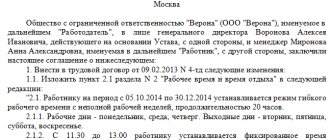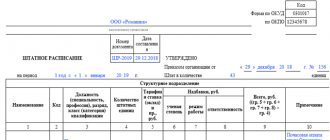Operating time and operating mode
The definition of the duration of work time is given in the Labor Code of the Russian Federation. Its duration is measured by the number of working hours per week. Art. 91 of the Labor Code of the Russian Federation predetermines the standard duration of no more than 40 hours per week, and in Art. 92 of the Labor Code of the Russian Federation specifies categories of persons whose working hours must be reduced. For example, the Labor Code of the Russian Federation establishes:
- the maximum number of working hours per week for workers under 16 years of age is 24 hours;
- for disabled people of groups 1 and 2 - special standards not exceeding 35 hours.
The professional field also influences the length of work time. Most doctors and teachers are supposed to work within 36 hours a week.
Business needs determine the types of operating modes:
- So, an employer can assign a work week of 5 days with 2 days off or 6 days with 1 day off.
- In addition, the employer has the right to establish that the enterprise or individual site will have irregular working hours, or to choose summarized recording of working hours.
Important! In any working mode, it is necessary to comply with the standard working hours.
So, for example, summarized recording of working hours can be used by companies that have continuous production, a medical hospital, and those engaged in security activities.
Cumulative work time means that the work duration required by law is not observed daily, but during the accounting period. The period for summing up work time is determined by the employer, but not more than 1 year.
The employer must approve all the features of the work schedule in the regulations and familiarize employees with them. Such regulations are the internal labor regulations.
A sample of the rules according to which the internal labor regulations are determined at the enterprise can be found in the article “Internal Labor Regulations - Sample 2018”.
It is important for the employer to know the working time limit and have accurate data on the time worked by employees.
Notes for the 2021 production calendar
According to Article 112 of the Labor Code of the Russian Federation, non-working holidays in 2021 are:
- January 1, 2, 3, 4, 5, 6 and 8 - New Year holidays ;
- January 7 - Nativity of Christ ;
- February 23 - Defender of the Fatherland Day ;
- March 8 - International Women's Day ;
- May 1 - Spring and Labor Day ;
- May 9 - Victory Day ;
- June 12 - Russia Day ;
- November 4 is National Unity Day .
If a day off coincides with a non-working holiday, the day off is transferred to the next working day after the holiday, with the exception of weekends coinciding with non-working holidays in the period from January 1 to January 8. The Government of the Russian Federation transfers two days off from the number of days off that coincide with non-working holidays, from January 1 to January 8, to other days in the next calendar year in the manner established by part five of this article.
Production calendar for 2021. In accordance with the calendar for 2021, the New Year holidays will last 10 days, the first working day will be January 9. In February 2021, Russians also have three days off in a row: from February 23 to 25. In March, Russians will rest on Thursday, March 8th. In April there will be a working Saturday on April 28th. In 2021, a pleasant surprise awaits Russians during the May holidays: four weekends in a row - from April 29 to May 2 inclusive, and also in May, Victory Day will be on Wednesday. In June, you will also be able to rest for three days in a row - June 10, 11 and 12, but for this you will have to work on Saturday, June 9. In November, Russians also have three days off in a row - November 3, 4 and 5. In 2021, the last day will be Monday, so in order to better prepare for the New Year celebrations, you will need to work on Saturday, December 29th.
For the purpose of rational use by employees of weekends and non-working holidays, weekends may be transferred to other days by federal law or a regulatory legal act of the Government of the Russian Federation. In this case, the regulatory legal act of the Government of the Russian Federation on the transfer of days off to other days in the next calendar year is subject to official publication no later than a month before the start of the corresponding calendar year. The adoption of regulatory legal acts of the Government of the Russian Federation on the transfer of days off to other days during the calendar year is permitted subject to the official publication of these acts no later than two months before the calendar date of the established day off.
Download calendar for 2021
Production calendar for 2018 . PDF format, print version in A4, A3, A2 formats, optimal for black and white printer Production calendar for 2018 . PDF format, printable version in A4, A3, A2 formats, optimal for color printer Production timesheet-calendar for 2021 . PDF format, printable version in A4, A3, A2 formats, optimal for a black and white printer Production timesheet calendar for 2021 . PDF format, print version in A4, A3, A2 formats, optimal for color printer Working time standards for 2018 . PDF format, print version in A4, A3, A2 formats, optimal for black and white and color printers Production calendar. Especially for Android. Free application Calendar code for your website or blog Calendar code for the forum
Why do you need to know the standard working hours?
Preparing a schedule according to which employees should work is relevant for any business.
To find out what this document is and why it is needed, read the article “How to draw up a working time schedule?” .
It is impossible to do without knowledge of the standard working hours for the period of drawing up the schedule, especially with accumulated working hours.
Calculation of payment for overtime is impossible without a limit on working hours in the month of calculation. Strict control of overtime will help protect yourself from disputes with employees and the labor inspectorate, the time of which cannot exceed 4 hours for one employee for 2 days in a row and 120 hours per year (Article 99 of the Labor Code of the Russian Federation).
The employees themselves need to know the norm. Even at the stage of applying for a job, it is approved by the parties in the employment agreement. Exceeding it means processing, which must be paid at an increased rate. An incomplete schedule must also be in writing to be legal. As a rule, incomplete schedules are used in collaboration with part-time workers, for whom individual standards are approved.
Standard man-hours in 2021
The number of man-hours worked for the year before its end can be determined using the production calendar, information on vacations, plans for hiring new employees, as well as other documentation that characterizes the use of labor time and the movement of labor.
Based on this, the standard man-hours in 2021 will be:
- If the week is forty hours - 1973;
- If the week is thirty-six hours - 1775.4;
- If the week is twenty-four hours - 1182.6.
Where to find information about standard working hours
Information about standard working hours is contained in the production calendar, which initially contains data from various information sources. To create such a document, a regular calendar is used, taking into account the holidays established by the Labor Code of the Russian Federation and the transfer of weekends to the corresponding year approved by the Government of the Russian Federation.
The production calendar is not included in the list of mandatory documents; its approval by ministries or departments is not required.
This calendar contains the following information:
- Standard working hours (monthly, quarterly and annual).
- The value of this norm for different numbers of hours per working week. Standards for 24-, 36- and 40-hour weeks are indicated separately.
- How many working days, weekends and holidays are included in which month?
For weeks with 5 and 6 working days, separate production calendars must be drawn up, since they have significant differences as defined by the Labor Code of the Russian Federation.
Let us give, for example, how many days of different categories there will be in 2021 in both cases:
- provided that work is carried out 5 days a week, there will be 247 working days, weekends and holidays - 118;
- if work is carried out 6 days a week, there will be 299 working days, weekends and holidays - 66.
The annual standard working hours in 2021 for both types of modes will not differ. It will be:
- if an employee works 40 hours a week - 1,970 hours a year;
- if 36 hours - 1,772.4 hours per year;
- if 24 hours - 1,179.6 hours per year.
Standard working hours for 2021
The standard working time is the amount of time that an employee needs to work during a certain specified period (month, quarter, year). We'll tell you what the standard working hours are for 2021.
Standard working hours for 2021
An important task for a HR specialist is to correctly determine the standard work time, because thanks to it, the workload and corresponding payments for work are established.
What are the working hours standards for 2021 (table below)? Employees and HR specialists are always concerned about the question of what duration of the labor process is considered normal.
Labor legislation states that 40 hours per week is the normal duration of work. Work and rest schedules in institutions are approved taking into account this figure. However, a schedule of 24 or 36 hours may be normal.
The monthly working time standard for 2021 is determined based on the weekly one, and the number of hours worked by the employee may vary.
Production calendar 2021
For an accountant and HR specialist, a production calendar becomes an assistant in their activities. It contains a large amount of information about holidays, weekends, and shortened days. The document, for example, indicates how many such days the corresponding period includes, what the work standard is for working weeks of different lengths (24, 36, 40 hours) in each half-year, quarter, month and year as a whole. From the document you can find out what dates certain professional holidays fall on.
The calendar helps the accountant correctly calculate wages, sick leave, vacation pay, and determine work schedules. This document will help the employee choose the appropriate period for vacation.
In 2018, the calendar shows the following important events:
1. Weekends have been postponed
- from Saturday 06.01 to Friday 09.03;
- from Sunday 07.01 to Wednesday 02.05;
- from Saturday 28.04 to Monday 30.04;
- from Saturday 06/09 to Monday 06/11;
- from Saturday 29.12 to Monday 31.12.
2. Holidays are days off
- from 01.01 to 08.01 - New Year holidays;
- 07.01 - Christmas;
- 23.02 — Defender of the Fatherland Day;
- 08.03 — International Women's Day;
- 01.05 — Spring and Labor Day;
- 09.05 — Victory Day;
- 12.06 — Russia Day;
- 04.11 — Day of National Unity.
3. Abbreviated days are:
- 22.02;
- 07.03;
- 28.04;
- 08.05;
- 09.06;
- 29.12.
How to calculate labor standards
In determining the normal duration of work, the order of the Ministry of Health dated August 13, 2009 No. 588n plays a decisive role.
The duration of work during the week, established for the employee, determines the norm for him. The basis is a calculation schedule containing five working days and two days of rest, as well as the duration of the working day or shift.
In the case where an employee has a work week of 40 hours, the duration of work per day is 8 hours; with a 36-hour week - 7.2 hours; at 24 hours - 4.8 hours. Existing work and rest regimes are determined by these figures.
On the eve of the holiday, the duration of work is reduced by one hour (Part 1 of Article 95 of the Labor Code of the Russian Federation). In 2018, such days fall on the following dates: 02/22, 03/07, 04/28, 05/08, 06/09, 12/29. If the Government approves the transfer of a day off to a working day, the duration of work is similar to the duration of the working day to which the day off is transferred. Thus, work on the specified dates will be shorter.
For example, let’s compare two months and see what the standard working time was for June 2021 and what the standard working time was in July 2021.
Calculation example
In June there are 20 working days and 10 days off (calculated as a work week of five working days and two days off).
The normal period (taking into account one day shortened by 1 hour) is:
- with a work week of 40 hours - 159 hours (8 hours x 20 days - 1 hour);
- at 36 hours - 143 (7.2 x 20 - 1);
- at 24 hours - 95 (4.8 x 20 - 1).
In July there are 22 working days and 9 days off.
The norm for the period will be:
- with a work week of 40 hours - 176 hours (8 x 21);
- at 36 hours - 158.4 (7.2 x 22);
- at 24 hours - 105.6 (4.8 x 22).
Working hours standards
The work schedule (five or six days) affects the established work norm.
With a five day week
With five working days, the quarterly norms and number of days are as follows:
In 2021, with a five-day week, there are 6 long periods for rest:
- 12/30/2017–01/08/2018 (New Year holidays);
- 23.02–25.02 (Defender of the Fatherland Day);
- 08.03–11.03 (International Women's Day);
- 29.04–02.05 (Spring and Labor Festival);
- 10.06–12.06 (Russia Day);
- 03.11–05.11 (National Unity Day).
One holiday - May 9, 2021 (Victory Day) - midweek.
With a six day week
With six working days, the quarterly norms and number of days are as follows:
Work standards for 2021 as a whole
In 2021 - 247 days of work (including 6 shortened by one hour) and 118 days off and non-working holidays (subject to working a work week, including five working days and two days off).
The total working time is:
- with a 40-hour work week - 1970 hours:
(8 x 247 days - 6 hours = 1,970);
- with a 36-hour work week - 1772.4 hours:
(7.2 x 247 days - 6 hours = 1,772.4);
- with a 24-hour work week - 1179.6 hours:
(4.8 x 247 days - 6 hours = 1,179.6).
How to calculate the norm for summarized accounting
Cumulative accounting is a labor regime of a special nature, which is based on established schedules.
The payment option for work is determined by the employer. It can be:
- hourly rate (calculated based on the number of hours worked in a particular month);
- official salary (fixed amounts paid every month).
When installing summarized accounting, you should select the optimal accounting period: month, quarter or year. In this situation, the employer chooses. A period exceeding one year is not provided.
When introducing summarized accounting, the following must be observed:
- The regime is being implemented in those institutions where it is not possible to establish compliance with working hours on an ongoing basis.
- The amount of work time for a specified period cannot exceed the standards provided for by law.
- Compliance with the schedule is mandatory.
- The duration of overtime work is calculated at the end of the accounting period.
Calculation example
Let's calculate the duration of work for a 40-hour work week. To do this, you need to divide 40 hours by 5 days and multiply by the number of days of work in the corresponding month. To avoid counting yourself, you can check it in the production calendar.
Let's determine the actual number of hours worked in the 2nd quarter of 2018. For example, an employee worked 173 hours in April; May - 163 hours, June - 163). Total - 499 hours. The norm per quarter is 485 hours. As a result, processing time is 14 hours.
In accordance with the law, we will register it as overtime and pay it as follows:
- the first two hours in time and a half;
- the remaining 12 are in doubles.
The payment is transferred in the last month of the quarter.
Source: https://ppt.ru/art/rabota/normi-vremeni
Monthly hours in 2021
The monthly working hours depend on the number of working days and weekends in each specific month.
The Labor Code of the Russian Federation limits the maximum amount of working time to 40 hours per week. For some categories of employees, 36- and 24-hour work weeks are established. That is, when creating a work schedule, you should rely specifically on the above numbers.
That is, with a standard 40-hour work week, the formula for calculating the monthly hours will look like this:
MN = NN / DNk x RDfact – H, where
MN – monthly norm;
NN – weekly norm equal to 40 hours;
DNA – number of working days in a week;
RDfact – actual number of working days in a month;
H - the number of hours by which pre-holiday working days are reduced.
Let's consider the calculation procedure in practice:
In May 2021, there are 31 calendar days, 20 working days, 11 holidays and weekends, of which 1 day is shortened.
MN = 159 hours (40 hours / 5 days x 20 days - 1 hour).
If you need to calculate working hours for a year at once, then you should multiply by the number of working days in a year.
That is, for 2021, with a 5-day working week, the number of working hours is calculated as follows:
40 hours / 5 days x 247 days - 6 days = 1970 hours.
Time standards for 36- and 24-hour weeks are calculated in a similar way.
Please note: for a 6-day week, the working hours are the same: 40, 36 and 24 hours a week.
The average monthly number of working days for a five-day week: 247 / 12 = 20.58 days, for a six-day week 298 / 12 = 24.83.
For the number of working days and holidays in each month of 2018, see our production calendar for 2018:
- with a 5- day work week ;
- with a 6- day work week .
norma_chasov.jpg
The standard working time for the 2021 reporting year, broken down by month, varies due to the unequal length of working weeks for different categories of personnel. In the standard version, the weekly work rate is 40 hours (8 hours daily with two days off, one of which is on Sunday). For some groups of employees, the employer is required to establish a reduced working time - 36 hours per week or 24 hours (with daily work of 7.2 and 4.8 hours, respectively).
Independent calculation of the working standard may also be necessary if the enterprise employs minor workers. The limit values for the duration of daily work for them are determined by Art. Labor Code of the Russian Federation.
Monthly working hours for 2021 are lowest in January. This is due to the long New Year holidays. There is one public holiday in February; before this date, the working day for all employees must be shortened by 1 hour.
The length of working hours is also affected by the postponement of weekends and holidays. For 2021, the list of such transfers was approved by the Government in Resolution No. 1250 dated October 14, 2017. The standard working hours for March 2021 takes into account the holiday and the transfer from January 6. Due to this, two additional days of rest and one shortened working day were formed during the month.
Read also: Normal working hours
The work schedule in April was also adjusted by postponements. In May there are long weekend breaks that are typical for this month.
The working time standard for June 2021 contains a postponement of days off, implemented within one month. The hourly work standard is set taking into account the public holiday on June 12 and a shortened shift the day before (20 working days x 8 hours in each working day - 1 hour shortened before the holiday = 159 hours per month).
The working time standard in July 2021 does not have any “holiday” nuances; it reflects only full working days. Let's look at an example of calculating the July standard:
- in relation to a basic 40-hour week – 176 hours (22 working days x 8 hours of daily work);
- for a 36-hour weekly output, the standard is 158.4 hours (22 working days x 7.2 hours of work per day);
- with a 24-hour weekly norm, the hourly working time per month will be 105.6 hours (22 working days x 4.8 hours of daily work).
The working hours in August 2021 do not include holidays or shortened days. There are no additional days of rest in September-October. There is one holiday in November, but before it there is no reduction in working hours. In December there is an intra-month transfer and 1 shortened day on the 29th.
Results
Work time standards are necessary data for organizing the work process.
The working hours limit does not depend on the operating mode and is dictated by the Labor Code of the Russian Federation, as well as industry regulations. The standard working days will be different for different operating modes approved by the Labor Code of the Russian Federation and dictated by business needs. You can find more complete information on the topic in ConsultantPlus. Free trial access to the system for 2 days.
Production calendar 2021 during the “five-day week”
Look at the 2021 production calendar based on a five-day work week.
Below we present a quarterly production calendar for a five-day work week (with weekends and holidays).
.








